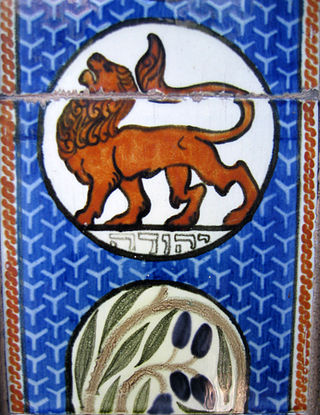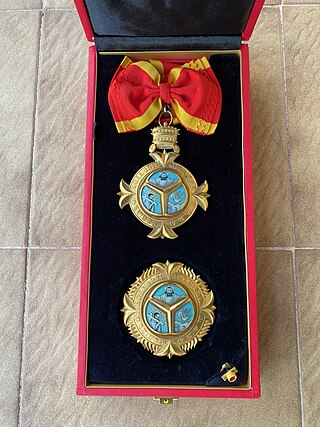
Haile Selassie I was Emperor of Ethiopia from 1930 to 1974. He rose to power as Regent Plenipotentiary of Ethiopia (Enderase) for Empress Zewditu from 1916. Haile Selassie is widely considered a defining figure in modern Ethiopian history, and the key figure of Rastafari, a religious movement in Jamaica that emerged shortly after he became emperor in the 1930s. He was a member of the Solomonic dynasty, which claims to trace lineage to Emperor Menelik I, believed to be the son of King Solomon and Makeda, the Queen of Sheba.

The Lion of Judah is a Jewish national and cultural symbol, traditionally regarded as the symbol of the tribe of Judah. The association between the Judahites and the lion can first be found in the blessing given by Jacob to his fourth son, Judah, in the Book of Genesis of the Hebrew Bible.

The emperor of Ethiopia, also known as the Atse, was the hereditary ruler of the Ethiopian Empire, from at least the 13th century until the abolition of the monarchy in 1975. The emperor was the head of state and head of government, with ultimate executive, judicial and legislative power in that country. A National Geographic article from 1965 called imperial Ethiopia "nominally a constitutional monarchy; in fact [it was] a benevolent autocracy".

Prince Makonnen Haile Selassie, Duke of Harar was the second son, and second-youngest child, of Emperor Haile Selassie of Ethiopia and Empress Menen Asfaw. He was made Mesfin of Harar upon the coronation of his parents in 1930.

Amha Selassie was Emperor-in-exile of Ethiopia. As son of Haile Selassie, he was Crown Prince and was proclaimed monarch three times. He was first proclaimed Emperor during an unsuccessful coup attempt against his father in December 1960, during which he alleged that he was detained and compelled to accept the title. After his father was deposed in a later coup, he was proclaimed King in absentia by the Derg on 12 September 1974 in an act which he never accepted as legitimate and that ended in the abolition of the Ethiopian monarchy on 21 March 1975. He was again proclaimed Emperor in exile on 8 April 1989. This time he sanctioned the proclamation and accepted its legitimacy. After his accession, his full reign name was His Imperial Majesty Emperor Amha Selassie I, Elect of God, Conquering Lion of the Tribe of Judah and King of Kings of Ethiopia.

Princess Tenagnework Haile Selassie, GBE baptismal name Fikirte Mariam, of Ethiopia was the eldest child of Emperor Haile Selassie and Empress Menen Asfaw.

Yohannes IV was Emperor of Ethiopia from 1871 to his death in 1889 at the Battle of Gallabat, and king of Tigray from 1869 to 1871. In his earlier years, he rebelled against Tewodros II; having risen to power in the 1860s, he maintained the policy of Tewodros, that of continued unification and also implemented a policy of touring entire regions and meetings with governors. He assisted the British in their British expedition to Abyssinia which ended in Tewodros' suicide, from which Yohannes was rewarded in ammunition and artillery. He regarded Islam as a hindrance to the stability of the state he built. In foreign policy, he had disagreements and military conflicts with both Isma'il Pasha of the Khedivate of Egypt and Muhammad Ahmad during the latter's Mahdist War.

The Solomonic dynasty, also known as the House of Solomon, was the ruling dynasty of the Ethiopian Empire from the thirteenth to twentieth centuries. The dynasty was founded by Yekuno Amlak, who overthrew the Zagwe dynasty in 1270. His successors claimed he was descended from the legendary king Menelik I, the supposed son of the biblical King Solomon and the Queen of Sheba, in order to legitimize the dynasty's assumption of power. Although this claimed ancestry gave the dynasty its name, there is no credible evidence that the dynasty was descended from Solomon or the Davidic line. The Solomonic dynasty remained in power until 1974, when its last emperor Haile Selassie was overthrown by a coup d'état.

Until the end of the Ethiopian monarchy in 1974, there were two categories of nobility in Ethiopia and Eritrea. The Mesafint, the hereditary nobility, formed the upper echelon of the ruling class. The Mekwanint were the appointed nobles, often of humble birth, who formed the bulk of the aristocracy. Until the 20th century, the most powerful people at court were generally members of the Mekwanint appointed by the monarch, while regionally, the Mesafint enjoyed greater influence and power. Emperor Haile Selassie greatly curtailed the power of the Mesafint to the benefit of the Mekwanint, who by then were essentially coterminous with the Ethiopian government.
Princess Sophia Desta was the youngest daughter of Ras Desta Damtew and Princess Tenagnework Haile Selassie, and granddaughter of Emperor Haile Selassie I of Ethiopia. She was educated at Clarendon School for Girls in the United Kingdom together with her three sisters, Aida, Hirut Desta (Ruth) and Sebel. Princess Sophia was imprisoned, mistreated and humiliated in the Alem Bekagn Kerchele prison, Addis Ababa together with her sisters, other princesses of the Imperial Family, from 1974 until 1988.
Princess Sara Gizaw, Duchess of Harar was the widow of Prince Makonnen, Duke (Mesfin) of Harar and second son of Emperor Haile Selassie of Ethiopia.
Medferiashwork Abebe, baptismal name Amete Maryam, was the titular empress consort of Amha Selassie, emperor-in-exile of Ethiopia. Her full title used by monarchists was "Her Imperial Majesty, Empress Medferiashwork", but she was officially regarded in post-Derg Ethiopia as "Her Imperial Highness Princess Medferiashwork Abebe".

Prince (Abeto Lij)Girma Yohannes Iyasu is the Iyasuist claimant to the throne of Ethiopian Empire. He is also known by the name Girma Amente Ghebresillasie.
The Imperial Order of Solomon was an order of knighthood of the Ethiopian Empire founded in 1874. A special class Collar was created by Empress Zewditu in 1922. It was a split off from the Order of the Seal of Solomon and created as an independent order with a single grade of "Collar" by Emperor Haile Selassie I in 1930. Members are identified as a "Knight" of the Order of Solomon, with the use the post-nominal initials KS.

The Imperial Order of Emperor Menelik II is an Ethiopian order established in 1924 by then-Regent Tafari Makonnen, during the reign of Empress Zewditu I, in order to honor the memory of Emperor Menelik II. The Imperial Order was often referred to as the Order of the Lion, for the lion depicted in the center of the red and green cross. The honor was designed by the Parisian firm Arthus-Betrand, and is presented in five grades: Knight Grand Cross, Knight Commander, Commander, Officer and Member.

The Order of the Seal of Solomon is an order of knighthood of the Ethiopian Empire, founded by Emperor Yohannes IV in 1874 as the highest imperial honour, containing five grades. In 1930, an even higher Order was established, i.e. the Order of Solomon, which was a split off from the Order of the Seal of Solomon. The Order was conferred on members of imperial house and upon persons who had rendered meritorious services.
The Order of the Star of Ethiopia was established as an order of knighthood of the Ethiopian Empire, founded by the Negus of Shewa and later Emperor of Ethiopia Menelik II in 1884–1885. It is currently awarded as a house order by the Crown Council of Ethiopia.

The Order of the Holy Trinity is an Ethiopian house order, established by Haile Selassie I on 2 November 1930, to celebrate his coronation. It currently ranks as the fourth highest award in the Ethiopian order of precedence.

The monument to the Lion of Judah is a statue of the Lion of Judah, a symbol of Ethiopian Emperors and Ethiopia, and is located in Addis Ababa.
 Order of Solomon [2]
Order of Solomon [2]  Order of the Seal of Solomon
Order of the Seal of Solomon  Order of the Queen of Sheba
Order of the Queen of Sheba  Order of the Holy Trinity
Order of the Holy Trinity  Order of Menelik II
Order of Menelik II  Order of the Star of Ethiopia
Order of the Star of Ethiopia  Order of Saint Anthony
Order of Saint Anthony 










